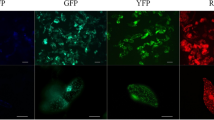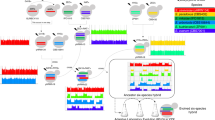Abstract
SOMATIC cell fusion has become a powerful tool in cell biology and genetics1–3 Until recently the standard reagent for increasing the rate of fusion in cultures of animal cells was inactivated Sendai virus4. In 1974 polymers of ethylene glycol (polyethylene glycol, PEG), over a wide range of molecular weights, were shown to be very effective, non-toxic chemical ‘fusogens’ for higher plant protoplasts5. They were then applied to fuse hen erythrocytes6 and these with yeast protoplasts7. Applied to mammalian, including human, cultured somatic cells they yielded hybrid cells capable of indefinite multiplication8,9. Applied to somatic cell protoplasts of two species of higher plants, they yielded hybrid protoplasts which regenerated, multiplied and developed into whole hybrid plants10. The list of cells and cell organelles fused has now expanded to include bacterial and fungal protoplasts and chloroplasts. It is reasonable to expect that PEG will induce the fusion of almost any two biological membranes and become an increasingly useful tool in their investigation6,11.
This is a preview of subscription content, access via your institution
Access options
Subscribe to this journal
Receive 51 print issues and online access
$199.00 per year
only $3.90 per issue
Buy this article
- Purchase on Springer Link
- Instant access to full article PDF
Prices may be subject to local taxes which are calculated during checkout
Similar content being viewed by others
References
Barski, G., Sorieul, S., and Cornefert, F., C.r. Acad. Sci. Paris, 251, 1825–1827 (1960).
Ephrussi, B., Hybridization of Somatic Cells (Princeton University, Princeton, 1972).
Harris, H., Cell fusion (Clarendon, Oxford, 1970).
Harris, H., and Watkins, J. F., Nature, 205, 640–646 (1965).
Kao, K. N., and Michayluk, M. R., Planta (Berlin), 115, 355–367 (1974).
Ahkong, Q. F., Fisher, D., Tampion, W., and Lucy, J. A., Nature, 253, 194–195 (1975).
Ahkong, Q. F., Howell, J. I., Lucy, J. A., Safwat, F., Davey, M. R., and Cocking, E. C., Nature, 255, 66–67 (1975).
Pontecorvo, G., Somatic Cell Genet., 1, 397–400 (1975).
Pontecorvo, G., in Baltimore Conference 1975: 3rd int. Workshop on Human Gene Mapping, Original Articles Series, 399–400 (National Foundation, New York, 1976).
Smith, H. H., Kao, K. N., and Combatti, N. C., J. Hered., 67, 123–128 (1976).
Maggio, B., Ahkong, Q. F., and Lucy, J. A., Biochem. J., 158, 647–650 (1976).
Hales, A., Somatic Cell Genet. (submitted for publication).
Norwood, T. H., Zeigler, C. J., and Martin, G. M., Somatic Cell Genet., 2, 263–270 (1976).
Maggio, B., Ahkong, Q. F., and Lucy, J. A., Biochem. J., 158, 651–653 (1976).
Davidson, R. L., O'Malley, K. A., and Wheeler, T. B., Somatic Cell Genet., 2, 271–280 (1976).
Author information
Authors and Affiliations
Rights and permissions
About this article
Cite this article
PONTECORVO, G., RIDDLE, P. & HALES, A. Time and mode of fusion of human fibroblasts treated with polyethylene glycol (PEG). Nature 265, 257–258 (1977). https://doi.org/10.1038/265257a0
Received:
Accepted:
Issue Date:
DOI: https://doi.org/10.1038/265257a0
This article is cited by
-
ISPD loss-of-function mutations disrupt dystroglycan O-mannosylation and cause Walker-Warburg syndrome
Nature Genetics (2012)
-
What history tells us XII. Boris Ephrussi’s continuing efforts to create a “genetics of differentiation”
Journal of Biosciences (2008)
-
Rapid kinetics of polyethylene glycol-mediated fusion
Somatic Cell Genetics (1981)
-
Kryokonservierung von Lymphozyten unter Verwendung von Polyethylenglykolen hohen Polymerisationsgrades
Blut (1981)
-
A simple method for fusing human lymphocytes with rodent cells in monolayer by polyethylene glycol
Somatic Cell Genetics (1981)
Comments
By submitting a comment you agree to abide by our Terms and Community Guidelines. If you find something abusive or that does not comply with our terms or guidelines please flag it as inappropriate.



